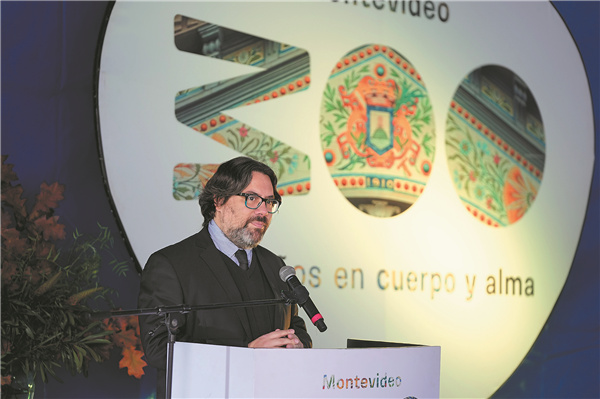Sculptor's work takes Chinese culture to the world
(Xinhua)| Updated : 2024-06-27
Print Print
Montevideo mayor Mauricio Zunino speaks at the unveiling of Wu Weishan's bronze artwork In Search of Wisdom on May 29, at the city's Batlle Park. [Photo/Xinhua]
Two bronze sculptures of the great Chinese philosophers Confucius and Lao Tzu were recently unveiled at Batlle Park in Montevideo, the capital of Uruguay.
The artwork, In Search of Wisdom — Confucius Asking Lao Tzu About the Tao, consists of two figures standing 7.8 meters tall and weighing 6.6 tons. It is a masterpiece by renowned sculptor Wu Weishan, who is the curator of the National Art Museum of China.
"The sculptures are the tallest and farthest-traveled pieces of all my works abroad," Wu says, emphasizing that the great sages of Chinese history transcend national boundaries, belonging not only to China but also to the world. "I want the world to see more Chinese figures standing tall."
The base of the artwork bears inscriptions narrating the story behind the sculptures in both Chinese and Spanish. The sculptures show Confucius asking Lao Tzu about the Tao, a central idea in Taoism. Both men lived more than two millennia ago.
The Tao represents the fundamental nature and source of the universe, and encompasses the underlying order and flow of all life.
During her visit to China in 2018, then vice-president of Uruguay Lucia Topolansky made a special trip to Wu's studio. Immediately captivated by the sculptures, she told Wu that she hoped his pieces would find a home in Uruguay in the hope of exposing future generations to the historic dialogue between these two momentous figures.
Six years later, the sculptures crossed the ocean and were placed among the trees in Batlle Park. When they were slowly lowered from a giant crane and finally touched the ground, Wu, who was watching the proceedings remotely, was extremely excited.
"The two sages have left their homeland, but they are not alone. They have kindred spirits all over the world who enjoy hearing them speak about benevolence, the Tao, and virtue," he says.
Over the last 2,000 years, the teachings of Confucius have spread to East Asia, Europe, and the Americas, leaving their mark the world over.
In the 16th century, Italian missionary Matteo Ricci translated the Confucian classics, known collectively as The Four Books, into Latin, and introduced them to Europe, sparking a wave of "Confucianism fever "and providing intellectual support for the European Enlightenment.
Lao Tzu's Tao Te Ching is one of the most widely translated Chinese classics. According to American Sinologist Misha Tadd, it has been translated into 97 languages, and appeared in 2,052 versions.
"The sculptures tell the story of Confucius and Lao Tzu seeking and sharing wisdom. In reality, this is also the relationship between China and the world," Wu says.
The sculptor explains that China first seeks wisdom from the world, saying that he aspires to demonstrate the Chinese people's modesty and curiousness through his work.
"At the same time, I hope to make Chinese culture known to the rest of the world, helping it expand and integrate with other cultures. This process itself is also sharing wisdom," Wu says.

 Xi's Moments
Xi's Moments  Shandong gains remarkable results in promoting high-quality development
Shandong gains remarkable results in promoting high-quality development  2025 National Two Sessions
2025 National Two Sessions